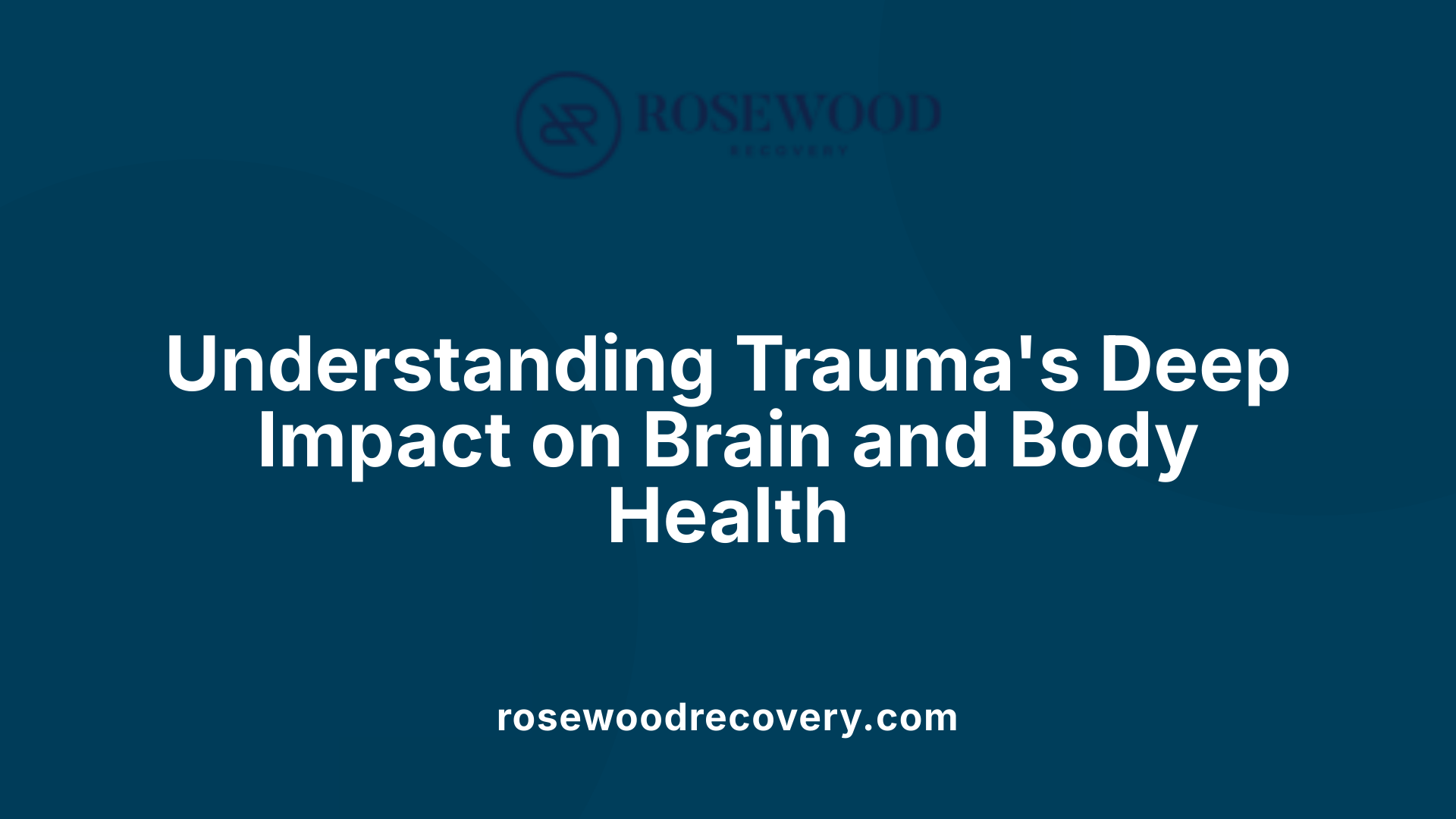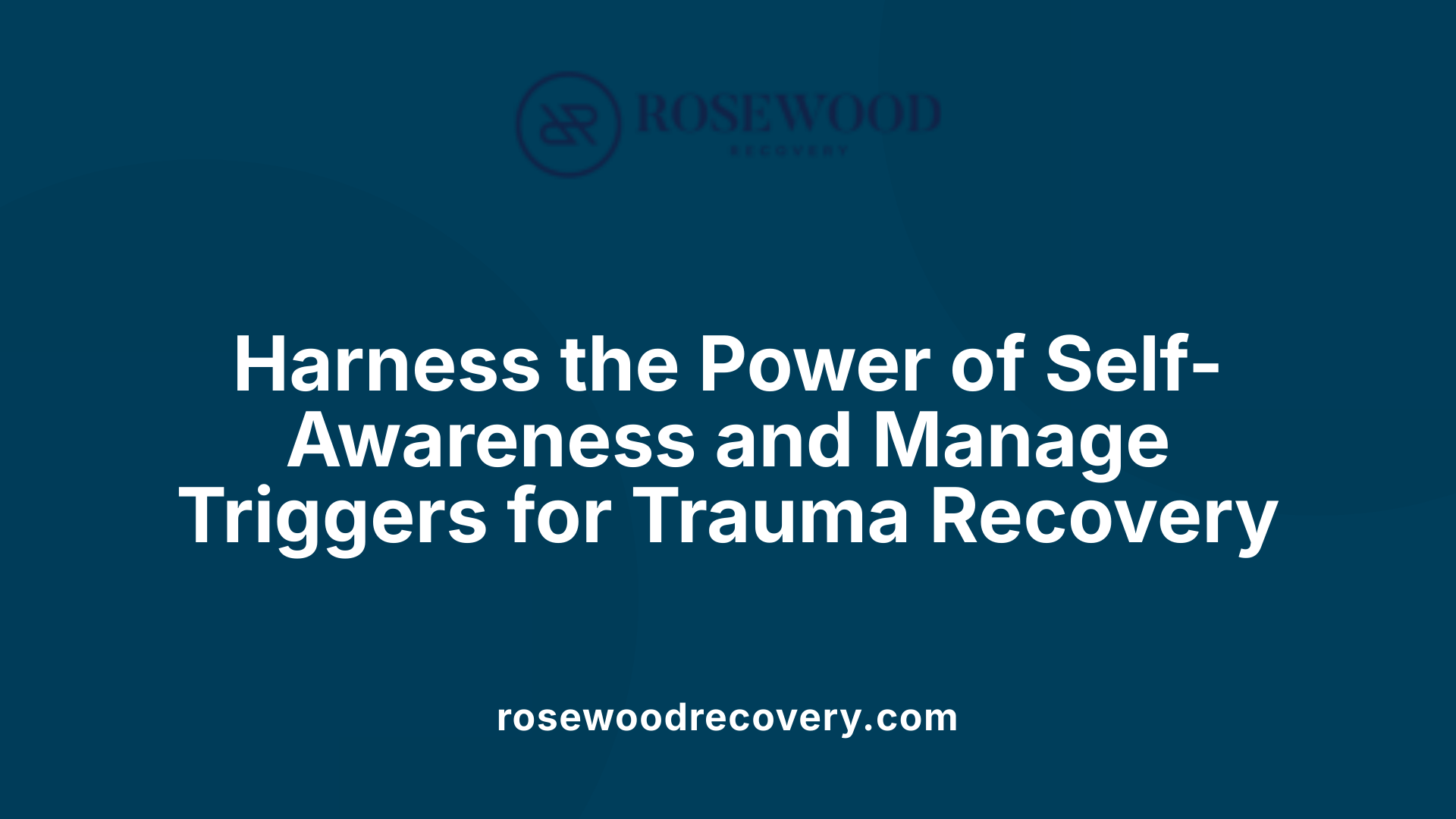How to identify and release emotional trauma in therapy
Unveiling the Pathways to Healing Emotional Trauma

Understanding the Foundations of Trauma and Its Recognition
Emotional trauma can deeply impact an individual's overall well-being, affecting mind, body, and relationships. Recognizing trauma is the first step in healing, involving attention to both internal sensations and external behaviors. Therapists employ comprehensive methods, including detailed interviews, observations, and assessments of physiological responses, to identify trauma. This approach ensures that treatment is tailored to the individual's unique experiences and symptom expressions, which can differ widely depending on the type and duration of trauma encountered.
Trauma Identification through Clinical Observation and Client Engagement
How do therapists identify trauma?
Therapists utilize a blend of methods to recognize trauma in their clients. Central to this process are detailed clinical interviews, where they systematically gather information about the client's history, including specific traumatic events and related emotional reactions. During these interviews, therapists pay attention to verbal disclosures as well as non-verbal signals that may indicate trauma.
Behavioral indicators serve as vital clues. For instance, avoidance of certain topics, sudden emotional shifts, or incongruent affect—where the client’s facial expressions do not match their spoken words—can suggest underlying trauma. Therapists observe how clients respond to questions about their experiences, noting signs of distress or discomfort that may not be explicitly verbalized.
Client participation and receptivity also offer essential insights. A client's willingness or resistance to engage with specific topics or therapy exercises can reveal levels of psychological distress or trauma-related barriers. High levels of dissociation, emotional numbing, or difficulty maintaining eye contact are additional signs that trauma may be influencing the client.
Verbal cues, such as mentions of intrusive memories, flashbacks, or feelings of safety and trust, help clinicians understand the trauma's impact. Non-verbal cues like trembling, tense muscles, or shaking can also point to unresolved trauma stored physically within the body.
The combination of these verbal, behavioral, and engagement cues enables therapists to form a comprehensive understanding of trauma. This holistic approach ensures that treatment plans are tailored to address both the emotional and somatic aspects of trauma, often involving trauma-informed modalities like EMDR, somatic experiencing, or CBT.
In summary, identifying trauma involves attentive listening, keen observation, and assessment of how clients participate in therapy. Recognizing these signs early helps create a safe environment for healing and guides effective intervention strategies.
Additional Resources for Trauma Identification in Therapy
| Method | Focus Area | Examples |
|---|---|---|
| Clinical Interviews | Gathering detailed history and symptoms | Trauma history, emotional reactions, triggers |
| Behavioral Indicators | Observing physical and emotional responses | Avoidance, affect incongruence, hypervigilance |
| Client Engagement | Assessing willingness to participate and openness | Resistance, trust levels, emotional receptivity |
| Verbal Cues | Language related to trauma disclosures | Memories, safety concerns, flashbacks |
| Non-verbal Cues | Body language and physical signs | Tension, trembling, muscle tightness |
Understanding and recognizing these signs are fundamental for effective trauma therapy, ensuring that interventions address both mind and body for holistic healing.
Recognizing Signs and Symptoms of Trauma in Self and Others
What are common signs and symptoms of emotional trauma to recognize in oneself or others?
Recognizing trauma is crucial for timely support and healing. Emotional signs often include numbness, anxiety, depression, irritability, and feelings of shame or guilt. People may seem disconnected or emotionally distant, showing a lack of interest in usual activities.
Cognitive changes are also common, such as intrusive thoughts, flashbacks, nightmares, and difficulty concentrating. Memory issues and confusion might impair daily functioning, and the mind often replays traumatic events unpredictably.
Behaviorally, individuals might withdraw from social interactions, avoid places or people that remind them of the trauma, and alter their routines significantly. They may engage in risky behaviors or exhibit agitation and restlessness.
Physical symptoms frequently accompany trauma responses. These include sleep problems like insomnia or nightmares, muscle tension, headaches, fatigue, and unexplained aches or pains. Increased heart rate, rapid breathing, and complaints of gastrointestinal upset are typical physical reactions.
Additionally, emotional and physical arousal can manifest as hypervigilance or being easily startled. Chronic stress can lead to a heightened state of alertness, making individuals jump at sudden noises or touch. These recognitions can guide individuals and support networks to seek appropriate help and begin trauma-informed healing processes.
Therapeutic Techniques for Releasing Trauma from the Body
What techniques and methods are effective for releasing emotional trauma through therapy?
Releasing emotional trauma from the body involves a variety of therapeutic techniques that focus on physical sensations, movement, and emotional expression. One highly effective approach is somatic experiencing, which helps individuals become aware of bodily sensations associated with trauma and guides them through releasing stored tension and stress. This body-centered method addresses the physical ramifications of trauma, such as muscle tightness or tremors, and facilitates nervous system regulation.
Movement and body awareness practices like yoga, dance therapy, and breathwork are also crucial. These techniques encourage voluntary movement and deep breathing, which can activate the body's natural relaxation responses and disarm the ongoing stress cycle. For example, trauma-informed yoga emphasizes gentle movements and mindful breathing to foster a sense of safety and presence.
Mindfulness and grounding exercises play an important role in helping trauma survivors stay connected with the present moment, counteracting dissociation and hypervigilance. Techniques such as focused breathing, sensory grounding, and progressive muscle relaxation calm the nervous system and reduce overwhelming feelings.
Expressive therapies like art, music, and inner child work support emotional release by allowing individuals to express stored feelings creatively and symbolically. These modalities can help process suppressed emotions, integrate traumatic experiences, and foster emotional resilience.
Effective trauma therapy typically combines these approaches within a safe, supportive environment. Evidence-based methods such as EMDR (Eye Movement Desensitization and Reprocessing), Cognitive Processing Therapy (CPT), Prolonged Exposure, and Trauma-Focused Cognitive Behavioral Therapy (TF-CBT) target traumatic memories, challenge negative beliefs, and gradually confront fears in a controlled manner.
Additionally, self-regulation strategies like mindfulness, grounding, and deep breathing help clients manage arousal symptoms, stay present, and create a sense of safety during emotional processing.
In summary, integrating somatic experiencing, movement practices, mindfulness, and expressive therapies creates a comprehensive approach to healing trauma by healing the mind and body simultaneously. Such methods empower individuals to reconnect with their bodily sensations, release stored tension, and reprocess traumatic memories, fostering deep and lasting recovery.
Understanding Trauma-Informed Therapeutic Approaches

Principles of trauma-informed care
Trauma-informed therapy is built on core principles that prioritize the safety, trust, and empowerment of clients. It recognizes that trauma impacts emotional, physical, and mental health and emphasizes creating a supportive environment that minimizes the risk of re-traumatization. Key principles include safety, transparency, peer support, collaboration, empowerment, and cultural sensitivity.
Creating a safe space
A safe therapeutic environment allows clients to feel secure enough to explore and process their traumatic memories. Therapists achieve this by establishing clear boundaries, practicing active listening, and fostering trust. The space is non-judgmental, respectful, and attuned to the client’s emotional cues, enabling open dialogue without fear of rejection or harm.
Tailoring treatment methods
Treatment approaches in trauma-informed care are flexible and individualized. Therapists assess the client’s unique experiences, readiness, and cultural background to select suitable methods. Modalities such as EMDR, somatic experiencing, narrative therapy, and attachment repair are often integrated based on the client's specific needs. This customization helps facilitate healing and resilience.
Reducing re-traumatization
A vital aspect of trauma-informed therapy is to prevent re-traumatization. Therapists are trained to recognize trauma triggers and respond compassionately. Techniques include pacing therapy sessions, emphasizing client control, and employing grounding and self-regulation strategies. The goal is to support recovery without overwhelming the individual.
What are trauma-informed therapeutic approaches?
Trauma-informed therapeutic approaches serve as frameworks that acknowledge the widespread influence of trauma. They focus on creating safe, empowering environments with principles like trustworthiness and cultural sensitivity. These approaches utilize diverse techniques—including EMDR, somatic therapies, and narrative work—tailored to process traumatic memories, regulate nervous systems, and restore self-worth. By understanding clients holistically and avoiding re-traumatization, trauma-informed therapy aims to guide individuals toward healing and resilience. Such approaches are essential for addressing the complex effects of trauma and fostering lasting recovery.
Somatic Techniques for Trauma Release and Body Integration

What are somatic techniques for trauma release, such as somatic experiencing or body integrative methods?
Somatic techniques for trauma release focus on reconnecting individuals with their bodily sensations to process and dispel stored emotional distress. Approaches like Somatic Experiencing® utilize body awareness, gentle movement, and sensory experiences to help clients gradually tolerate and discharge trauma-related activation.
These methods emphasize increasing interoception—the awareness of internal body states—and proprioception—the sense of body position in space. By doing so, individuals learn to recognize early signs of overwhelm and employ strategies to self-regulate before symptoms escalate.
During sessions, techniques such as resource development, grounding exercises, titration, and pendulation are employed. Titration involves carefully approaching traumatic sensations in small doses to avoid overwhelm, while pendulation facilitates shifting between states of tension and relaxation, promoting resilience.
Movement and imagery are incorporated—such as gentle stretching, dance, or guided visualization—to help integrate bodily experiences with emotional processing. Gentle touch therapies may also be used to foster a sense of safety and connection.
Safety and careful pacing are fundamental. Therapists prioritize titration and boundary setting to ensure clients do not re-experience trauma vividly. This gradual approach supports healing by renegotiating trauma responses at a physiological level.
Overall, somatic techniques aim to rewire the body's automatic responses, helping trauma survivors build resilience, restore a sense of safety, and reconnect to their vitality and strength.
Physical Body Responses as Indicators of Trauma Processing

How can physical indicators and body responses help in recognizing trauma?
Physical signals and bodily responses are vital clues in identifying trauma because they often manifest as tangible physiological reactions. These responses can include muscle tension, hyperarousal, sleep disturbances, an increased heart rate, and heightened startle reflexes. Such signs are the body's way of signaling the stress or danger it perceives, even if the individual is not consciously aware of trauma.
Immediate body responses, such as dissociation, numbness, or agitation, are often seen during or right after traumatic events. People may experience physical sensations like headaches, nausea, or stomach upset, indicating their nervous system is on alert. Persistent symptoms—nightmares, fatigue, hypervigilance, muscle tightness, and emotional numbness—can point to ongoing trauma effects that require attention.
Biological changes further support trauma recognition. Alterations in brain function, hormone levels (like cortisol), and neurotransmitter activity reflect the body's chronic stress response. For instance, a person with unresolved trauma might show signs like irregular heart rate variability or heightened inflammatory markers.
By paying attention to these bodily cues, both individuals and healthcare providers can detect trauma even when verbal communication is limited or trauma-related memories are not easily accessible. Recognizing these signs early allows for appropriate trauma-informed interventions, supporting recovery and emotional regulation. Through body awareness practices, individuals can reconnect with these signals, promoting healing and resilience.
For more insights, search for "Body responses and trauma recognition". Recognizing physical signals effectively guides timely therapeutic support and fosters a deeper understanding of trauma stored within the body.
Healing Strategies within Therapy Settings for Emotional Trauma
What are effective healing strategies for emotional trauma within therapy settings?
Effective healing strategies for emotional trauma in therapy involve a blend of approaches tailored to individual needs. Trauma-focused cognitive-behavioral therapy (TF-CBT), EMDR (Eye Movement Desensitization and Reprocessing), and trauma-informed psychodynamic methods are well-supported by research. These techniques help individuals process traumatic memories, challenge negative beliefs, and manage emotional responses.
In addition to talk therapies, somatic techniques and mindfulness practices are integral. Somatic therapies address physical tension stored in the body, while mindfulness and grounding exercises promote presence and emotional regulation. Creating a safe, trust-based environment is essential. Such a space allows clients to explore their trauma at their own pace without fear of re-traumatization.
Building coping skills and resilience is another vital component. This can include breathing exercises, creative arts, and social support engagement. These strategies support the nervous system’s healing process, helping clients regain a sense of control and safety.
In summary, combining evidence-based trauma therapies with body-awareness techniques and supportive environments fosters effective healing, empowering individuals to recover and rebuild their emotional wellbeing.
Understanding the Phases of Trauma Recovery and Healing
What are the typical recovery stages and processes involved in trauma healing?
Trauma recovery generally progresses through three main phases: safety and stabilization, processing and mourning, and reconnection and integration.
The first stage, establishing safety and stabilization, focuses on creating a secure environment where individuals feel protected. During this period, developing coping skills is vital to manage overwhelming symptoms such as anxiety, hypervigilance, and emotional volatility. Techniques like grounding exercises, mindfulness, and relaxation methods help clients regain control over their nervous systems.
Following stabilization, individuals move into the remembrance and mourning phase. Here, they process the traumatic memories and emotions, often with therapeutic support. This can involve talking therapies like EMDR or CBT, journaling, art, or creative activities that help make sense of the trauma’s impact. This stage allows for emotional release and understanding, which are crucial for healing.
The final phase, reconnection and integration, involves rebuilding trust, restoring relationships, and redefining personal identity beyond the trauma. It emphasizes resilience, acceptance, and living a meaningful life despite past distress. Techniques such as ongoing therapy, peer support, and new narratives support this reintegration.
Throughout these stages, tailored therapeutic approaches like EMDR, trauma-focused CBT, mindfulness, and somatic practices are utilized to promote emotional regulation and resilience. Healing is an individual journey—often non-linear—where each person gradually learns to live without being defined or controlled by their trauma, integrating the experience into a broader narrative of growth and recovery.
The Biological and Psychological Impact of Trauma on the Brain and Body

How Does Trauma Affect Brain Function?
Trauma can significantly alter how the brain processes information. It impacts areas responsible for memory, focus, and emotional regulation, often leading to intrusive thoughts, flashbacks, and difficulty concentrating. The brain's response to trauma can involve heightened activity in the amygdala, which detects threats, while the prefrontal cortex, responsible for rational thinking, may become less active.
What Role Do Stress Hormones Play?
When a traumatic event occurs, the body's stress response activates, releasing hormones like adrenaline and cortisol. While these hormones are essential for immediate survival, prolonged exposure can damage various organs and tissues, reduce immune function, and lead to chronic health issues such as inflammation and high blood pressure.
How Does Neurotransmitter Activity Change?
Trauma influences the activity of neurotransmitters, chemicals that relay messages in the brain. Imbalances in serotonin, dopamine, and norepinephrine are common, contributing to symptoms of depression, anxiety, and emotional dysregulation. These imbalances can hinder mood stability and increase vulnerability to mental health disorders.
Physical Health Effects of Trauma
The physical repercussions of trauma extend beyond the brain. Chronic stress from trauma can cause muscle tension, headaches, gastrointestinal issues, and fatigue. Over time, it may also weaken the immune system and increase risks for cardiovascular diseases. Many physical symptoms are manifestations of the body's stress response becoming dysregulated.
| Aspect | Impact | Additional Details |
|---|---|---|
| Brain Function | Memory disturbances, hyperarousal, emotional dysregulation | Activation of the amygdala, decreased prefrontal activity |
| Stress Hormones | Elevated adrenaline and cortisol levels | Prolonged levels lead to inflammation and tissue damage |
| Neurotransmitter Changes | Imbalanced serotonin, dopamine, norepinephrine | Affects mood, anxiety, and cognitive function |
| Physical Health | Chronic pain, fatigue, immune suppression | Linked to ongoing activation of stress response |
Recognizing these physiological changes helps in understanding trauma's extensive impact and underscores the importance of trauma-informed treatments that include physical, emotional, and neurological healing strategies.
The Role of Self-Awareness and Triggers in Trauma Healing

How does self-awareness aid in healing from trauma?
Self-awareness is a vital component in trauma recovery because it helps individuals recognize their own emotional and physical responses to triggers. By becoming more conscious of their feelings, thoughts, and bodily sensations, survivors can better understand how trauma manifests in their daily lives. This awareness allows them to identify early signs of distress and take proactive steps to manage their reactions.
Through practices like mindfulness and body scans, individuals learn to observe without judgment. This helps in creating a safe distance from overwhelming feelings and prevents automatic reactions that might reinforce trauma memories. As awareness deepens, people can differentiate between current reality and stored trauma responses, paving the way for more adaptive coping.
What are common trauma responses and triggers?
Trauma responses are automatic reactions to reminders or stimuli associated with past trauma. Common triggers include certain sounds, smells, sights, or even specific words that evoke memories of the traumatic event. These triggers activate the body's fight, flight, freeze, fawn, or fright responses.
Signs of triggers can include physical sensations such as stomach clenching, rapid heartbeat, muscle tension, or dissociation. Emotional reactions may involve intense fear, anger, sadness, or shame. Recognizing these responses is critical for managing reactions effectively.
How does emotional regulation contribute to trauma recovery?
Emotional regulation involves managing intense feelings so they do not overwhelm or control us. Developing this skill is crucial in trauma healing because it enables survivors to stay present and grounded during distressing moments. It reduces the likelihood of dissociation or impulsive behaviors that hinder recovery.
Techniques like deep breathing, grounding exercises, and progressive muscle relaxation help regulate emotions. These methods activate the parasympathetic nervous system, promoting calmness. Over time, improved emotional regulation enhances resilience, allowing individuals to handle triggers without becoming retraumatized.
What are effective self-regulation techniques?
Implementing self-regulation techniques supports trauma survivors in managing their responses. Some effective methods include:
- Breathwork: Slow, intentional breathing to calm the nervous system.
- Grounding Exercises: Engaging the senses with objects, sounds, or physical activities to reconnect with the present moment.
- Mindfulness Meditation: Observing thoughts and feelings non-judgmentally to reduce emotional reactivity.
- Progressive Muscle Relaxation: Tensing and relaxing muscle groups to release physical tension.
Regular use of these techniques fosters a sense of safety and control, which is fundamental to healing. As individuals practice, they develop a toolkit for navigating triggers more effectively, supporting long-term recovery and emotional stability.
A Holistic Approach to Trauma Recovery
Healing from emotional trauma is a complex, multifaceted process that involves recognizing physical and emotional signs, utilizing trauma-sensitive techniques, and creating a safe environment conducive to healing. Combining evidence-based psychotherapy with somatic modalities allows for a comprehensive approach that addresses mind, body, and emotional responses. Early intervention, patient education, and ongoing support are vital to effectively releasing trauma and fostering resilience. By understanding and applying these strategies, individuals and therapists can collaboratively journey toward recovery, embracing their inherent strength and capacity for transformation.
References
- Emotional and Psychological Trauma - HelpGuide.org
- 6 Signs Your Body is Releasing Trauma | Philadelphia Therapy
- Trauma-Informed Therapy - StatPearls - NCBI Bookshelf
- Releasing Trauma from the Body: A Path to Healing
- Signs Your Body is Releasing Trauma - Integrative Life Center
- Understanding the Impact of Trauma - NCBI
- How to Release Trauma From the Body | Charlie Health
More Articles
Recovery Begins Here
Click below to get in touch and schedule a consult call with our team to begin your journey towards happiness and freedom.
Rosewood Recovery does not discrimate against any person because of the race, color, religious creed, ancestry, age, sex, sexual orientation, gender identity, national origin, handicap or disability or the use of a guide or support animal because of the blindness, deafness or physical handicap.


.jpeg)


